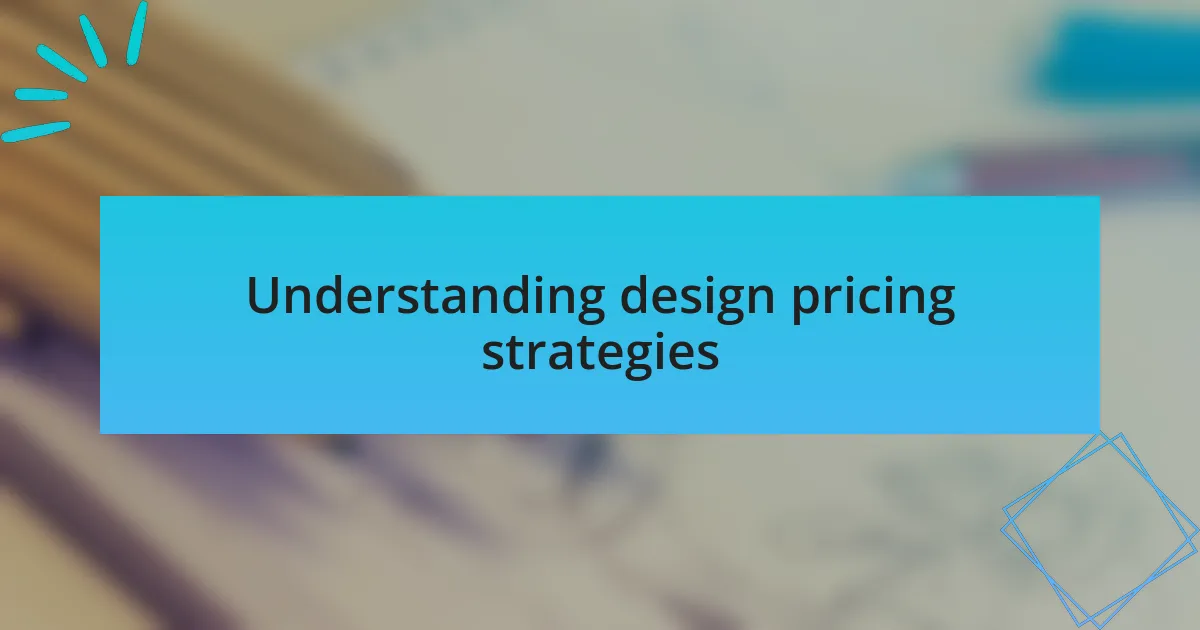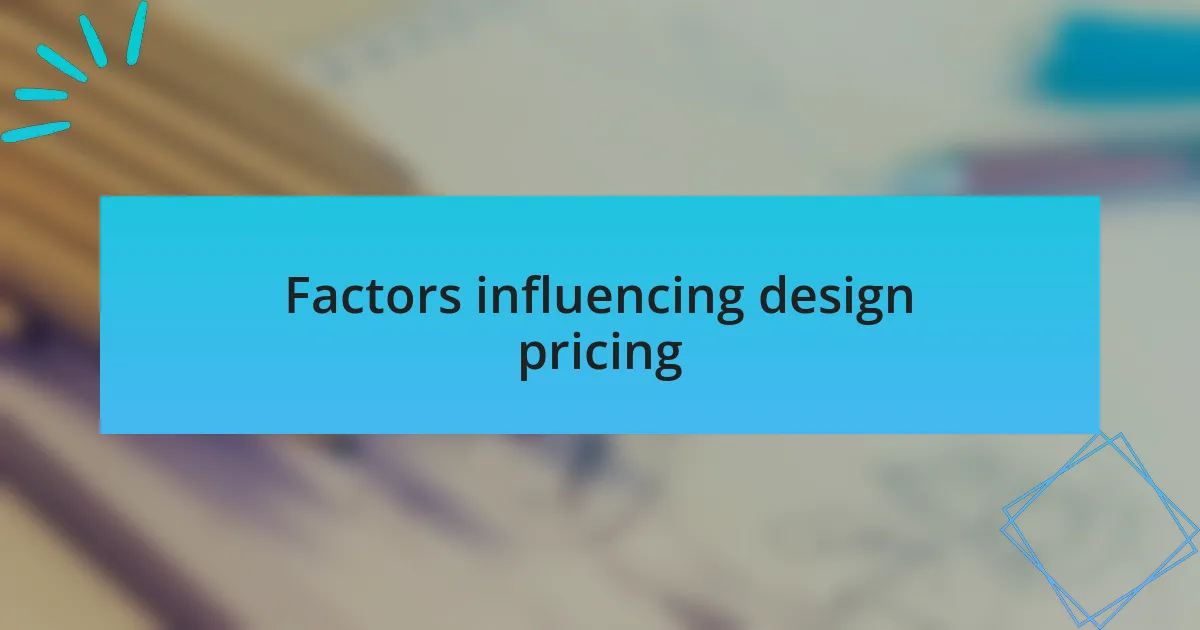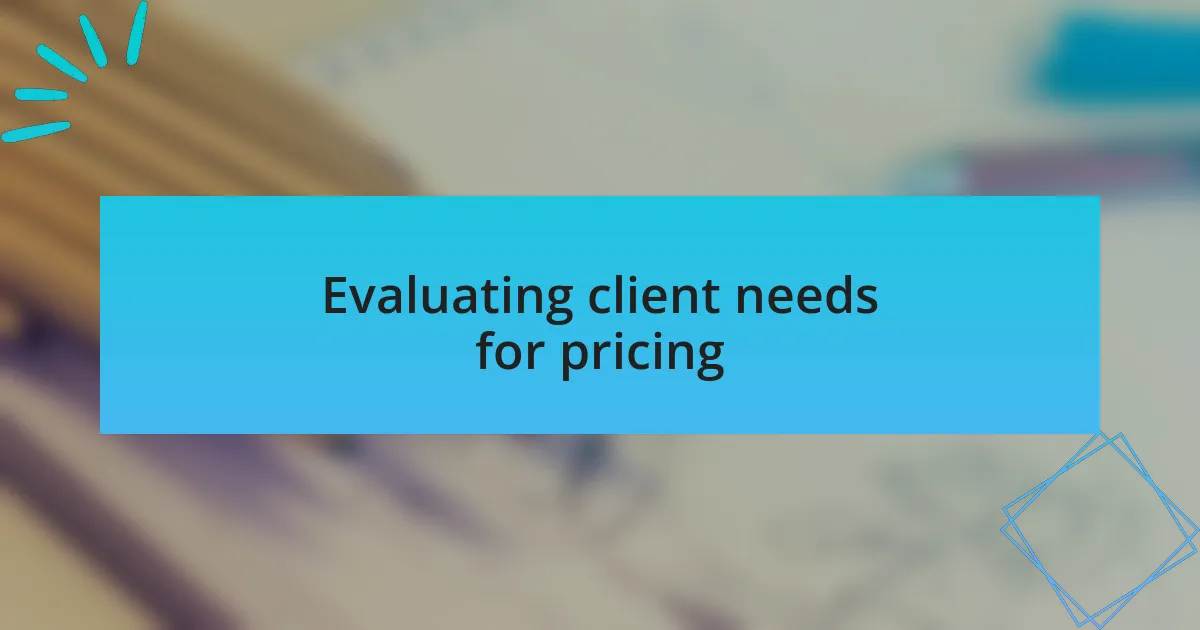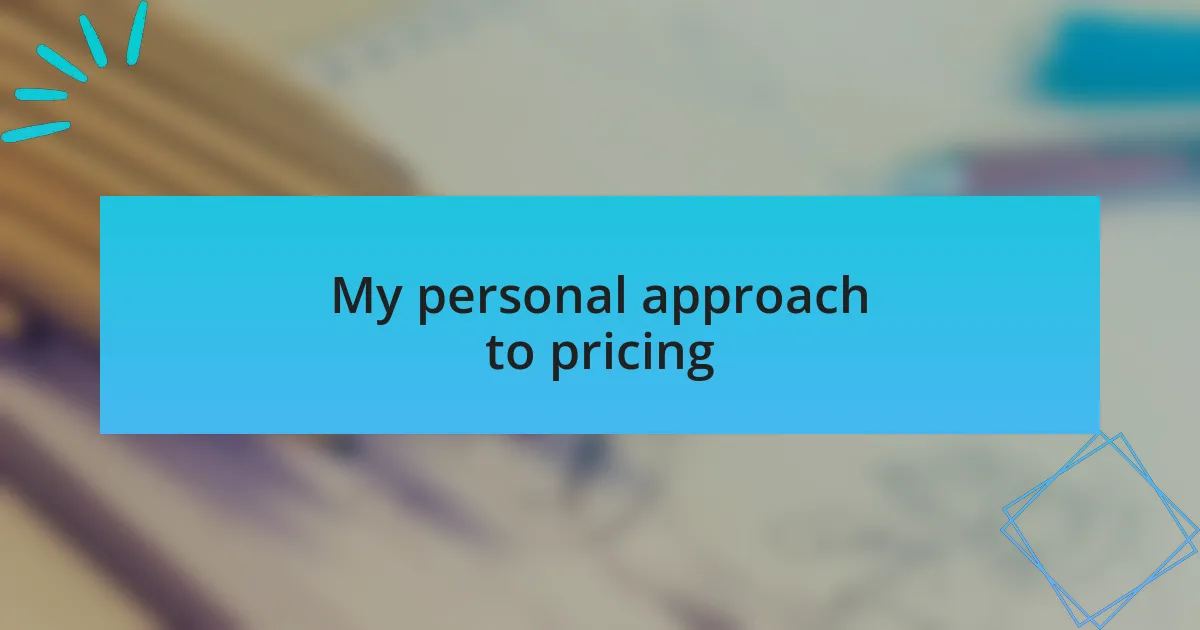Key takeaways:
- Shifting from hourly rates to project-based pricing emphasizes client value on outcomes.
- Understanding client needs and expectations is crucial for effective pricing and building long-term relationships.
- Transparency in pricing fosters trust, making clients more comfortable with the investment required for design services.
- Flexibility in pricing models can lead to better alignment with client goals and satisfaction.

Understanding design pricing strategies
Understanding design pricing strategies involves navigating through a range of methods that agencies can adopt, reflecting their unique approach and market positioning. I’ve often found myself pondering how different strategies resonate with clients. For example, when I shifted from hourly rates to project-based pricing, it prompted clients to value the outcomes rather than the time spent – a real eye-opener for both parties.
In my experience, value-based pricing can often yield surprising results. It forces you to articulate the true worth of your design work in relation to the client’s goals. I remember a project where, by framing the design as a means to enhance brand experience, I was able to increase the price significantly. This shift reinforced my belief that understanding a client’s needs deeply can redefine your pricing structure.
Moreover, it’s fascinating to see how tiered pricing can cater to various customer segments while still upholding your agency’s integrity. Have you ever thought about how offering budget-friendly packages alongside premium options can influence client perceptions? I’ve noticed that presenting a range of choices not only attracts a wider audience but also encourages clients to aspire towards higher-tier options. This strategy can cultivate long-term relationships, ensuring clients return with larger budgets as their business grows.

Common pricing models in design
When discussing common pricing models in design, flat-rate pricing often stands out for its simplicity. I recall a project where I offered a clear package with a fixed price, which led to a smoother client relationship. Clients appreciate knowing exactly what they will pay upfront; it removes the anxiety of unpredictable costs and builds trust. Have you ever experienced that sense of relief when you know the exact investment involved?
On the other hand, retainers can foster continuous collaboration and deeper partnerships. In my agency, we experimented with a retainer model for a client whose needs were ongoing rather than one-off. This approach not only stabilized our cash flow but also allowed us to dive deep into the client’s brand over time. I’ve seen it work wonders; clients become deeply engaged in the process, and we can adapt our strategies as their goals evolve. Isn’t it rewarding to watch a brand flourish because of that sustained investment?
Finally, hourly billing remains prevalent, although it’s not without its challenges. Personally, I initially struggled with conversations around billable hours, often worrying about how much time I spent versus the value created. Over time, I’ve learned to embrace it with a twist, framing it as an opportunity for transparency. When clients understand that I’m focusing on efficiency rather than just time, it reframes the discussion around productivity rather than cost. Have you found ways to address similar challenges in your own pricing conversations?

Factors influencing design pricing
One of the most significant factors influencing design pricing is the complexity of the project. I remember taking on a branding project that required extensive market research and multiple design iterations. The more intricate the work, the more time and resources it demands. Have you ever considered how the depth of research and creativity can change the final price? It’s often not just about designing; it’s about crafting a solution that addresses a client’s unique challenges.
Client expectations also play a critical role in setting design prices. I once had a client who had an expansive vision for their website but limited budget constraints. They wanted top-notch quality, and I had to navigate those expectations delicately. Balancing what the client dreams of with what they can realistically afford can be a tightrope walk, but it’s essential for a successful partnership. Isn’t it fascinating how perceived value can shift pricing dynamics?
Lastly, market demand significantly impacts what we charge for design services. In certain periods, when competition spikes, I’ve had to adjust my pricing to stay competitive while ensuring quality. It can be tough trying to find that sweet spot, but understanding the market landscape gives me a strategic advantage. Have you ever experienced the tension between valued services and competitive pricing? It truly challenges us to continuously innovate and refine our offerings.

Evaluating client needs for pricing
When evaluating client needs for pricing, it’s vital to engage them in meaningful discussions about their project goals. I recall a time when a client articulated their vision, yet it was clear they hadn’t fully grasped the scope of what they wanted. Taking the time to ask probing questions helped me pinpoint their true objectives and tailor the pricing accordingly. Have you ever faced a situation where initial impressions veiled the deeper needs of the client?
Understanding a client’s timeline can also greatly influence pricing. I once worked with a startup that was under immense pressure to launch their website for an upcoming event. The urgency shifted our pricing model, as we had to allocate resources more intensively. Isn’t it interesting how time constraints can alter not just the cost but also the way we approach a project? Taking their urgency into account was crucial to delivering a successful result without compromising on quality.
Lastly, I make it a point to unpack any potential future needs that a client might have during our discussions. A client once came in with a straightforward request for a logo redesign, but through our conversation, I uncovered their plans for an entire rebranding campaign. This insight allowed me to adjust the pricing to reflect a more comprehensive service offering. Have you found that digging deeper not only helps in pricing but also strengthens your relationship with clients? It certainly adds layers of value to our partnerships.

My personal approach to pricing
My personal approach to pricing is rooted in flexibility and understanding. I remember one project where we initially quoted a flat rate based on standard deliverables. However, after discussing the client’s evolving needs and preferences, I realized we needed a more dynamic pricing strategy. This adaptability not only met their expectations but also created a sense of partnership that made the experience more rewarding for both of us.
I truly believe that transparency in pricing is essential. Early in my career, I faced a situation where a client was surprised by hidden costs. That experience taught me the importance of outlining every aspect of the pricing structure upfront. Have you ever noticed how clarity fosters trust? I make it a priority to ensure clients know what they’re investing in and why, which ultimately leads to smoother collaborations.
When setting prices, I always consider the value delivered, not just the hours worked. I once charged a premium for a branding project because I understood its long-term impact on my client’s business. Reflecting on that, it’s evident that some projects transcend their initial scope. How can we effectively communicate this value? I find that sharing success stories can illuminate the return on investment, making clients more willing to embrace pricing that reflects the true worth of the design solutions we provide.